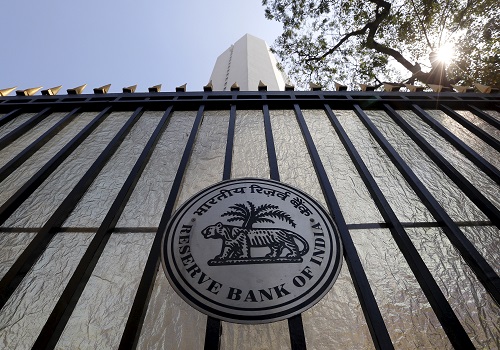Jeera trading range for the day is 25890-28730 - Kedia Advisory

Follow us Now on Telegram ! Get daily 10 - 12 important updates on Business, Finance and Investment. Join our Telegram Channel
Gold
Gold closed marginally lower by -0.09% at 62,108 as investors awaited the release of the Federal Reserve's meeting minutes. The minutes revealed that a majority of policymakers expressed concerns about the risks associated with premature interest rate cuts, emphasizing uncertainty about the duration of the current monetary policy stance. Participants highlighted the challenge of determining how long a restrictive policy would be necessary to achieve the Fed's 2% inflation target. Market expectations for Fed rate cuts have moderated, with traders now anticipating a total of 75 basis points in cuts this year, down from the previously forecasted 150 basis points. The Fed's cautious stance reflects the uncertain economic outlook, with a particular focus on inflation risks in the coming year. Fed Chair Jerome Powell emphasized the surprising strength of the US economy, driven by robust consumer demand and tightening labor conditions. Swiss gold exports surged in January, reaching their highest level since December 2016, driven by a 49% year-on-year increase in export volumes. Strong sales to China and Hong Kong contributed to this significant rise in monthly exports from the world's largest bullion refining and transit hub. Technically, the gold market witnessed long liquidation, with a 0.61% drop in open interest, settling at 13,374. Despite a price decline of -59 rupees, the market is finding support at 62,010, with a potential test of 61,915. Resistance is likely at 62,240, and a breakout could lead to testing 62,375.
Trading Ideas:
* Gold trading range for the day is 61915-62375.
* Gold settled flat ahead of the release of the Fed minutes.
* Fed concerned about the risks of cutting interest rates too soon
* Fed policymakers agreed on a cautious, slower approach to rate cuts
Silver
Silver prices exhibited a decline of -0.91%, settling at 70609, as investors eagerly awaited the minutes of the recent U.S. Federal Reserve policy meeting to gain insights into the potential timing of interest rate cuts. The minutes revealed that the majority of policymakers at the Fed expressed concerns about the risks associated with premature interest rate cuts, emphasizing the uncertainty regarding the duration of maintaining the current restrictive monetary policy stance to achieve the Fed's 2% inflation target. Recent warmer U.S. inflation reports have led the market to believe that the Fed may delay any interest rate cuts until the second half of the year, or even later. Geopolitical tensions added to market concerns, with reports indicating ongoing attacks by Houthi rebels on ships in the Red Sea. Bank of England Governor Andrew Bailey expressed comfort with investors betting on interest rate cuts in the UK this year. Despite raising the Bank Rate to 5.25% in August 2023 to address surging inflation, the BoE has refrained from further hikes, citing ongoing economic uncertainties. The market is pricing in a quarter-point reduction fully for August, highlighting the cautious approach adopted by the BoE amid inflation concerns. From a technical standpoint, the silver market indicates fresh selling, marked by a 0.36% increase in open interest, settling at 21,990. Prices witnessed a notable decline of -646 rupees. Support for silver is anticipated at 70280, with potential testing of 69945 levels. On the upside, resistance is likely at 71205, and a breakout above could lead to further testing at 71795 levels.
Trading Ideas:
* Silver trading range for the day is 69945-71795.
* Silver dropped with investors keenly awaiting Fed’s minutes.
* Fed policymakers expressed concerns about the risk of premature interest rate cuts
* Recent warmer U.S. inflation reports have the marketplace thinking the Fed will hold off on lower interest rates.
Crude oil
Crude oil closed higher by 0.26% at 6447, driven by escalating tensions in the Middle East that outweighed concerns about a weak demand outlook. The International Energy Agency's report highlighted a global oil demand slowdown due to the growing popularity of renewable energy sources. Investors are closely watching OPEC+'s decision in March on whether to extend output cuts into the next quarter. Houthi rebels' announcement that ships in the Red Sea and Arabian Sea are their latest maritime targets added to ongoing supply concerns. Iraq, the second-largest OPEC producer, exceeded its production quota, contrasting with Russia, which met its export cut target for January. However, Houthi militants in Yemen claimed responsibility for targeting two US ships in the Gulf of Aden, sparking worries about potential disruptions to shipping routes in the region. U.S. crude oil stockpiles surged unexpectedly last week, rising by 12.0 million barrels to 439.5 million barrels, surpassing expectations for a 2.6 million-barrel build. Gasoline and distillate inventories fell as refining dropped to its lowest levels since December 2022, according to the Energy Information Administration. Technically, the crude oil market saw short covering, with a 4.99% drop in open interest, settling at 5,158. Despite a price increase of 17 rupees, the market is finding support at 6369, with a potential test of 6290. Resistance is likely at 6501, and a breakout could lead to testing 6554.
Trading Ideas:
* Crudeoil trading range for the day is 6290-6554.
* Crude oil recovered amid supply disruptions due to Middle East tensions
* IEA’s report highlighted a slowdown in global oil demand due to the increasing popularity of renewable energy sources.
* Investors are eagerly anticipating OPEC+'s decision in March on whether or not to extend output cuts into the next quarter.
Natural gas
Natural gas saw a substantial surge, closing up by 11.84% at 147.4, as Chesapeake Energy announced a reduction in its 2024 gas production plans in response to the recent plunge in gas prices to a 3.5-year low. This move by Chesapeake follows a broader trend, with various gas producers such as Antero Resources, Comstock Resources, and EQT also cutting spending and reducing drilling activities due to a significant 31% decline in gas prices in 2024, following a 44% drop in 2023. LSEG reported an increase in gas output in the U.S. Lower 48 states to an average of 105.6 billion cubic feet per day (bcfd) in February from 102.1 bcfd in January, although still below the monthly record of 106.3 bcfd in December. Despite the increase, warmer-than-normal weather projections through March 6 led to a forecast of reduced U.S. gas demand in the Lower 48, including exports, from 130.3 bcfd this week to 117.5 bcfd next week. Technically, the natural gas market witnessed short covering, with a significant 27.95% drop in open interest, settling at 41,035. Despite a price increase of 15.6 rupees, the market found support at 138.9, with a potential test of 130.3. Resistance is anticipated at 152.2, and a breakout could lead to testing 156.9. The technical overview suggests a market reacting to production cut announcements amid falling prices, with traders monitoring key support and resistance levels for potential trend development.
Trading Ideas:
* Naturalgas trading range for the day is 130.3-156.9.
* Natural gas soared after Chesapeake Energy cut the amount of gas it plans to produce in 2024
* Other gas producers, including Antero Resources, Comstock Resources, and EQT, also plan to reduce drilling.
* Gas output in the U.S. Lower 48 states rose to 105.6 bcfd in February from 102.1 bcfd in January.
Copper
Copper closed higher by 0.2% at 726.6, buoyed by optimism that economic support measures in China would stimulate industrial activity, driving demand for essential input materials. Additionally, expectations of looser monetary policy in the US contributed to improved industrial sentiment for economies linked to US credit markets, supporting the outlook for base metals. Beijing's extension of economic support measures aimed at countering contracting manufacturing activity and addressing concerns of accelerating deflation further contributed to positive market sentiment. However, poor industrial demand in China was evident in the persistent decline of the Yangshan copper premium, reflecting cautious purchasing behavior by factories. Meanwhile, inventories in major Chinese warehouses surged by over 180% year-to-date to reach 86,000 tonnes. The International Copper Study Group (ICSG) reported a surplus of 20,000 metric tons in the global refined copper market in December, a significant shift from the 123,000 metric tons deficit recorded in November. For the first 12 months of the year, the market showed an 87,000 metric tons deficit, compared to a 434,000 metric tons deficit in the same period the previous year. World refined copper output in December was 2.39 million metric tons, slightly exceeding consumption of 2.37 million metric tons. Technically, the copper market experienced short covering, with a notable 13.39% drop in open interest, settling at 2,193. Despite a price increase of 1.45 rupees, the market found support at 724.6, with a potential test of 722.6. Resistance is anticipated at 729.1, and a breakout could lead to testing 731.6.
Trading Ideas:
* Copper trading range for the day is 722.6-731.6.
* Copper rose amid hopes that China economic support will spur demand
* Beijing extended a series of economic support measures to spur economic activity and counter the contractionary manufacturing activity
* Copper market in 20,000 metric tons surplus in Dec 2023 – ICSG
Zinc
Zinc closed higher by 0.64% at 213.4, propelled by a weaker U.S. dollar and optimistic expectations for a robust demand outlook in China. Beijing's efforts to boost its economy and support the struggling property sector included a significant reduction in the benchmark mortgage rate, marking the most substantial cut announced on Tuesday. This move was part of broader measures to stimulate credit demand and revive the property market, contributing to positive sentiments for zinc demand. The five-year loan prime rate (LPR) was lowered by 25 basis points to 3.90%, while the one-year LPR remained unchanged at 3.45%. The market responded positively to these measures, anticipating increased demand for zinc in China. However, the Russian Ozernoye mine's delay in zinc concentrate production until at least the third quarter of 2024 and the full capacity ramp-up postponed to 2025 added a note of caution to the supply outlook. Zinc inventories rebounded recently, particularly in LME warehouses, with stocks climbing by 14% over the past 10 days to reach a one-month high of 216,675 metric tons. The discount for the cash over the three-month zinc contract widened to four-month highs due to substantial inflows into LME warehouses, reflecting market dynamics influenced by supply and demand considerations. Technically, the zinc market observed short covering, with a notable 27.06% drop in open interest, settling at 1,628. Despite a price increase of 1.35 rupees, the market found support at 212.6, with a potential test of 211.7. Resistance is anticipated at 214.6, and a breakout could lead to testing 215.7.
Trading Ideas:
* Zinc trading range for the day is 211.7-215.7.
* Zinc gains after China's efforts to boost its economy and property sector.
* China announced its biggest reduction in the benchmark mortgage rate, as authorities sought to prop up the struggling property market.
* Russian new Ozernoye mine has delayed the start of zinc concentrate production until at least the third quarter of 2024.
Aluminium
Aluminium prices held steady, remaining unchanged at 199.3, amid concerns about supplies in anticipation of the United States announcing sanctions against Russia over the death of opposition leader Alexei Navalny. President Joe Biden confirmed that the U.S. would unveil significant sanctions targeting Russia's defense and industrial bases. The support for base metals is augmented by China's stimulus measures, particularly its substantial cut in the benchmark mortgage rate to bolster the struggling property market. Global primary aluminium output in January increased by 2.4% year-on-year to 6.039 million tonnes, according to data from the International Aluminium Institute (IAI). However, aluminium stocks at major Japanese ports saw a 5.8% rise to 332,900 metric tons at the end of January, adding an element of caution. The People's Bank of China (PBoC) made its first rate cut since June 2023, reducing the 5-year loan prime rate by 25 basis points to 3.95% in February. This move aimed to stimulate credit demand and counteract the property market downturn. From a technical standpoint, the aluminium market indicates long liquidation, marked by a 23.68% drop in open interest, settling at 1773. Prices remained unchanged at 199.3 rupees. Support for aluminium is identified at 197.8, with a potential test of 196.1 levels. On the upside, resistance is likely at 201.6, and a move above could lead to further testing at 203.7 levels.
Trading Ideas:
* Aluminium trading range for the day is 196.1-203.7.
* Aluminium settled flat after seen supported on concern about supplies
* China announced its biggest cut in the benchmark mortgage rate to support the struggling property market.
* Aluminium stocks at three major Japanese ports rose 5.8% to 332,900 metric tons
Cottoncandy
The cotton market continues to exhibit resilience amidst a backdrop of supply concerns and sustained consumption, driving Cottoncandy prices up by 0.71% to settle at 59960. Factors such as lower ending stocks in the 2023/24 U.S. cotton balance sheet, coupled with higher exports and reduced mill use, have contributed to a bullish sentiment. With exports forecasted to increase by 200,000 bales to 12.3 million, and Indian cotton becoming increasingly competitive in global markets, the demand-supply dynamics remain robust. India's potential to export 2 million bales in the 2023/24 marketing year underscores its growing significance in the cotton trade, despite an expected production dip of 7.7%. The Cotton Association of India's retention of its pressing estimate further solidifies the market's current trajectory. Total cotton supply till the end of January 2024 stands at 210.05 lakh bales, with consumption estimated at 110.00 lakh bales and exports at 9.00 lakh bales. Looking ahead to the cotton season ending September 30, 2024, the total supply remains steady at 345 lakh bales, with domestic consumption mirroring last year's figures and exports remaining stable at 14 lakh bales. From a technical standpoint, the market is experiencing fresh buying momentum, evident from a 5.64% increase in open interest, settling at 506. This uptrend is complemented by a price increase of 420 rupees. Key support for Cottoncandy lies at 59660, with potential downside testing at 59360. Conversely, resistance is expected at 60180, with a breakthrough likely leading to prices testing 60400 levels. Overall, while supply concerns and demand dynamics continue to buoy prices, technical indicators suggest a bullish trend in the near term, supported by increasing open interest and positive price performance.
Trading Ideas:
* Cottoncandy trading range for the day is 59360-60400.
* Cotton prices gained spurred by concerns over supply
* USDA weekly sales report a 69% increase in exports from previous week
* CAI estimates domestic consumption for the 2023-24 season to remain flat at 311 lakh bales.
* In Rajkot, a major spot market, the price ended at 27634.1 Rupees dropped by -0.05 percent.
Turmeric
The Turmeric market experienced a slight decline, settling down by -0.89% at 15434, largely attributed to slower buying activities in anticipation of stock releases ahead of the commencement of new crops. Despite this, the downside was limited due to reduced supplies in the spot market, supported by delayed harvesting of the new crop and tighter ending stocks. These factors are expected to maintain positive sentiments in the market in the near term. Export of Turmeric has witnessed fluctuations, with a drop of 2.27% during Apr-Dec 2023 compared to the same period in 2022. However, there was a notable increase in December 2023 compared to November 2023, though still lower than December 2022 figures. Conversely, Turmeric imports during Apr-Dec 2023 decreased by 25.43% compared to the previous year, although there was a slight increase in December 2023 compared to November 2023. The market is also influenced by various other factors, including concerns over improved crop conditions due to favorable weather and the establishment of PM Modi's Turmeric Board in Telangana, which has sparked concerns among farmers in Maharashtra regarding the headquarters' location. In terms of technical analysis, the market is undergoing long liquidation, indicated by a drop in open interest by -0.25%. Despite the price decline, support levels are identified at 15254, with a potential downside target of 15076. Conversely, resistance is expected at 15682, with a breakout above this level potentially pushing prices towards 15932.
Trading Ideas:
* Turmeric trading range for the day is 15076-15932.
* Turmeric dropped as buying activities has been slower in expectation of new crops.
* However, downside seen limited supported by reduced supplies in the spot market.
* Export has been slow down in recent months and expected to increase in wake of series of festivals ahead.
* In Nizamabad, a major spot market, the price ended at 14359.75 Rupees gained by 1.18 percent
Jeera
The recent performance of the Jeera (cumin) market reflects a downward trend, with prices settling down by -0.64% at 27040, primarily driven by expectations of higher production in key cultivating regions such as Gujarat and Rajasthan. Acreage for Jeera cultivation has surged to a four-year high in the current rabi season, with farmers responding to record prices from the previous marketing season. This significant increase in cultivation area, particularly in Gujarat and Rajasthan, underscores the strong correlation between market prices and acreage. In Gujarat, Jeera cultivation has expanded to cover 5.60 lakh hectares, representing a substantial 160% increase from the previous year, surpassing the normal acreage for the state. Similarly, Rajasthan has witnessed a 25% increase in cultivation area, reaching 6.90 lakh hectares. Global demand for Indian Jeera has slumped as buyers prefer alternative origins like Syria and Turkey due to comparatively higher prices in India. However, there was a notable increase in exports in December 2023 compared to November 2023, although still lower than December 2022. In terms of technical analysis, the market is currently witnessing long liquidation, indicated by a drop in open interest by -2.97%. Despite the downward price movement, support levels are identified at 26470, with a potential downside target of 25890. Conversely, resistance is expected at 27890, with a breakout above this level potentially pushing prices towards 28730.
Trading Ideas:
* Jeera trading range for the day is 25890-28730.
* Jeera prices dropped due to higher production prospects
* In Gujarat, Cumin sowing witnessed very strong growth by nearly 103% with 530,030.00 hectares against sown area of 2022
* Stockists are showing interest in buying on recent downfall in prices triggering short covering.
* In Unjha, a major spot market, the price ended at 30674.5 Rupees dropped by -0.45 percent.
Views express by all participants are for information & academic purpose only. Kindly read disclaimer before referring below views. Click Here For Disclaimer












 320-x-100_uti_gold.jpg" alt="Advertisement">
320-x-100_uti_gold.jpg" alt="Advertisement">









